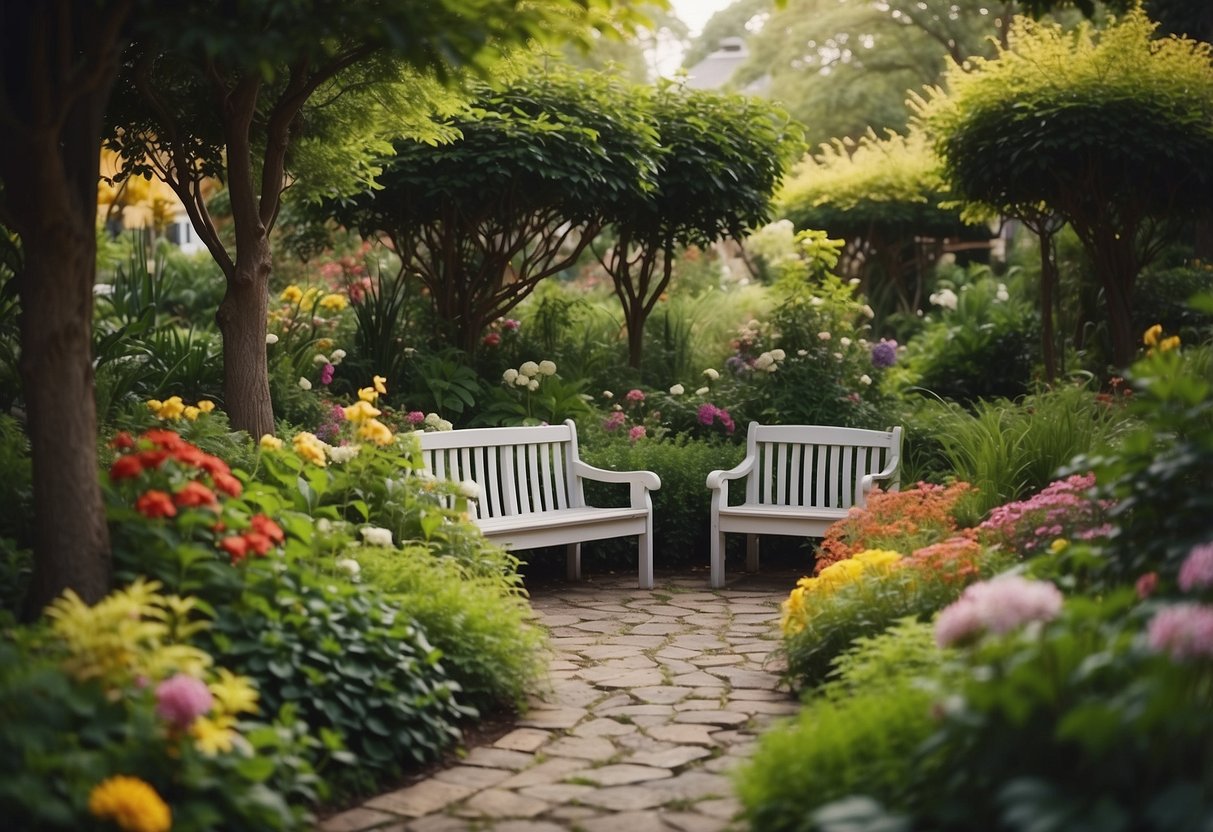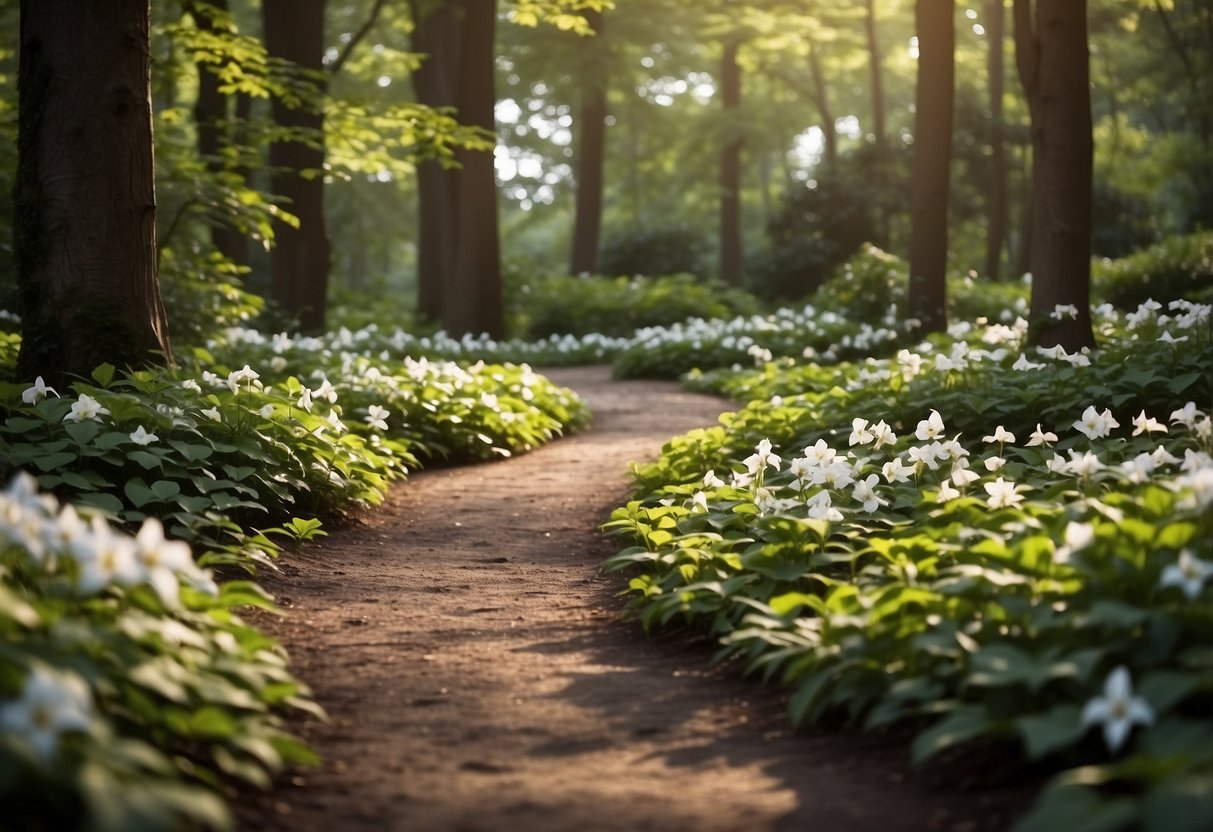Shade Garden Ideas: Creative Ways to Make Your Yard Thrive
Creating a shade garden can be a delightful way to add beauty and variety to your yard. Shady spots often feel cooler and provide a peaceful escape, perfect for relaxing on a hot day. There are many ways to design a garden that thrives in the shade, giving you plenty of options to explore.

How do you transform a shady area into a vibrant garden? With the right plants and design ideas, even the darkest spots can burst with color and texture. From choosing shade-loving plants to incorporating features like water elements and planters, there’s so much potential for creating a lush and inviting garden.
1) Hostas

Hostas are perfect for your shade garden. They come in many colors, sizes, and shapes, making them a versatile choice. Their lush, vibrant leaves can turn a dark corner into a green haven.
You can mix tall and short varieties. Place tall hostas in the back and shorter ones in front to create layers. Try pairing them with other shade plants like ferns, dicentra, and heuchera.
Hostas also look great next to paths or borders. They add texture and depth to your garden, making it feel more alive and inviting.
2) Japanese Painted Fern

The Japanese painted fern is a perfect addition to your shade garden. Known for its colorful, arching, and triangular silvery leaves with purplish midribs, it brings elegance and vibrancy.
These ferns thrive in very acidic soil and deep shade, making them ideal for spots where other plants struggle. They grow slowly and reach about 12 to 18 inches tall and 24 inches wide, adding a stunning visual.
Planting and caring for the Japanese painted fern is simple. They do well in containers and garden beds. Ensure you plant them about 24 inches apart and keep the soil evenly moist throughout the growing season. For more details on caring for this fern, visit Better Homes & Gardens.
3) Astilbe

Astilbe is a top choice for adding brightness to shaded areas in your garden. Known for its feathery plumes and fern-like foliage, it brings both texture and color.
Planting astilbe is straightforward. Place it in a pre-dug hole, fill with soil and organic material, and water well. This helps the roots establish.
With varieties like Astilbe ‘Bridal Veil’ and Astilbe ‘Dark Side of the Moon’, you can find different colors and heights to suit your needs.
4) Bleeding Heart

Bleeding Heart is a great choice for a shade garden. This plant thrives in part-shade and adds beauty to your garden with its unique heart-shaped flowers.
You should plant it in well-draining, rich soil. Make sure to keep the soil moist to help the plant thrive.
You can expect these plants to bloom in early spring. The flowers are delicate and come in colors like deep red and white. Bleeding Heart can grow about 28 to 30 inches tall and wide, adding dimension to your garden’s shady spots. For more details, check out this guide.
5) Heucheras

Heucheras, also known as coral bells, are perfect for your shade garden. They have colorful, vibrant leaves that add visual interest.
You can grow them in partial shade or even in full sun, depending on the variety. They thrive in rich, well-draining soil.
Heucheras are hardy in USDA zones 4-9, making them versatile for many gardens. They also offer long bloom times with their charming bell-shaped flowers.
6) Trilliums

Trilliums are perfect for your shade garden. These woodland wildflowers thrive in shaded areas and provide a touch of natural beauty.
They grow best under deciduous trees, needing well-drained, moist soil with a layer of leaf mulch. You can even plant them alongside ferns and hostas for a lovely combination.
Trilliums bloom in spring, usually from April to May, bringing vibrant color to your garden before going dormant. For planting tips, check out this guide on growing trilliums.
7) Lungwort

Lungwort is an excellent addition to your shade garden. It grows well in partial to full shade and is hardy in zones 3-9. It produces clusters of tiny pink or white flowers that deepen in color as they age.
Lungwort’s attractive, variegated foliage makes it a standout in any shady spot. It’s also a favorite of hummingbirds and bees. Consider planting it alongside Hostas, Astilbes, and Hellebores for a beautiful, relaxing garden.
You can find more details on Lungwort care at Heirloom Roses.
8) Coral Bells

Coral Bells are a fantastic addition to your shade garden. They have beautiful, rounded leaves that come in many colors, including deep purples, reds, and greens. This makes them perfect for adding a pop of color.
These plants are easy to care for and thrive in shady spots. They can grow well in pots or directly in the ground.
For a striking effect, pair Coral Bells with green hostas and ferns. This combination will bring an attractive contrast to your garden. Learn more about growing Coral Bells.
9) Foxglove

Foxglove is a great plant for shady gardens. Its tall spikes of tubular flowers come in colors like pink, purple, white, and yellow. You can plant foxglove in well-draining soil to keep it happy.
Space the plants 12-18 inches apart to give them room to grow. They look lovely in odd corners of your garden or along borders. Check out more on growing foxglove at Easy Shade Gardening.
10) Solomon’s Seal

Solomon’s Seal is a great choice for your shade garden. This plant has arching stems and small, bell-shaped white flowers in the spring.
Later in the season, those flowers turn into bluish-black berries.
You can easily grow Solomon’s Seal by ensuring it has shade, moist soil, and a good climate. This plant adds a nice touch to any garden bed.
Learn more about how to plant and grow Solomon’s Seal.
Benefits of Shade Gardens

Shade gardens offer unique advantages such as conserving water, reducing heat around your home, and requiring low maintenance compared to sun gardens.
Conserving Water
Shade gardens help save water. Because they are not exposed to direct sunlight all day, the soil retains moisture longer. This means you don’t have to water as often. Plants in shade gardens typically need less water overall, which is a great benefit if you live in an area with water restrictions.
Also, many shade-loving plants are naturally drought-tolerant. This makes them ideal for creating a sustainable garden. By choosing the right plants, you can create a beautiful space that doesn’t require constant watering, saving both time and resources.
Reducing Heat
Having a shade garden can make your outdoor space cooler. Plants that thrive in the shade help keep the ground and air temperature lower. This can be especially useful during the hot summer months.
Trees and large shrubs provide shade that keeps your home cooler, reducing the need for air conditioning. This not only helps the environment but can also lower your energy bills. Additionally, having cooler spots in your garden makes it more comfortable for you to spend time outside.
Low Maintenance
Shade gardens are typically easier to care for than sunny gardens. They require less watering, fewer fertilizers, and less pruning. Shade-loving plants like ferns, hostas, and vinca are generally hardy and can withstand various conditions.
Weeds are less of a problem in shade gardens because they don’t get enough sunlight to grow rapidly. This means you’ll spend less time weeding. Also, the plants often have slower growth rates, so they don’t need frequent trimming and upkeep. This makes shade gardens a great option for busy gardeners or those who prefer a more hands-off approach.
Choosing the Right Plants

Creating a beautiful shade garden involves selecting plants that thrive without full sun exposure. Focus on perennials, annuals, and ground covers that perform well in shady conditions.
Perennials for Shade
Perennials are plants that come back year after year. For a shade garden, look for species like hostas, ferns, and astilbes. Hostas are known for their large, vibrant leaves and do well in partial to full shade. Ferns, available in many types, offer delicate fronds that add texture.
Astilbes produce feathery plumes of flowers and prefer moist, shaded areas. You can also consider heucheras (coral bells), which come in various colors and brighten up shady spots. Columbines are another choice, with their unique flowers and shade tolerance.
Annuals for Shade
Annuals complete their life cycle in one growing season, making them ideal for adding seasonal color. Impatiens are a popular choice for shade gardens due to their bright blooms and ability to thrive in indirect light. Begonias are another excellent option; they come in various colors and forms, including upright and trailing types.
Coleus plants are known for their variegated leaves and can add a splash of color to your garden. Fuchsia plants, with their dangling, bell-shaped flowers, are perfect for hanging baskets in shady areas. Torena, or wishbone flower, offers continuous blooms under low-light conditions.
Shade-Loving Ground Covers
Ground covers spread across the ground, filling in bare spots and helping to control weeds. Ajuga (bugleweed) is a shade-tolerant ground cover with dark leaves and seasonal blue flowers. Pachysandra is another good choice; it forms a dense mat of green foliage and produces small white flowers in spring.
Vinca minor (periwinkle) provides evergreen cover and purple flowers. Liriope (monkey grass) is known for its grassy leaves and spikes of purple flowers. Lamium (dead nettle) offers variegated foliage and small blooms, adding both texture and color to shady garden beds.
Design Tips for Shade Gardens

Creating a beautiful shade garden can be both easy and rewarding. Focus on layering plants, using containers, and incorporating paths and seating to make the most of your shaded spaces.
Layering Plants
Layering plants adds depth and interest to your shade garden. Start with taller plants at the back or center, like hostas and ferns. These create a lush backdrop.
In front, place medium-height plants such as astilbes and heucheras which add color and texture. Finish with low-growing plants like vinca or ajuga to cover the ground.
Mixing different plant heights helps fill gaps and creates a full, natural look. Use plants with varying leaf colors and shapes to keep the garden visually stimulating.
Using Containers
Containers are perfect for shade gardens. They let you add height and flexibility to your design. Choose containers in various sizes and materials to match your garden style.
Fill them with shade-loving plants like caladiums, impatiens, and begonias. These plants thrive in limited sunlight and bring splashes of color to shaded areas.
You can move containers around to refresh the look or protect plants during extreme weather. Containers also work well in small spaces or for highlighting specific spots in your garden.
Incorporating Paths and Seating
Paths and seating areas make your shade garden more accessible and enjoyable. Use natural materials like flagstone or gravel to create winding paths through your garden.
These paths allow you to explore and tend to your plants easily. Adding benches or chairs provides relaxation spots where you can enjoy the cool shade.
Consider placing seating near fragrant flowers or water features to enhance the experience. This makes your shade garden not just a visual delight but a pleasant retreat.







